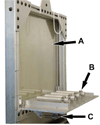An assessment of memory awareness in tufted capuchin monkeys (Cebus apella)
- PMID: 18712532
- PMCID: PMC2676690
- DOI: 10.1007/s10071-008-0180-1
An assessment of memory awareness in tufted capuchin monkeys (Cebus apella)
Abstract
Humans, apes, and rhesus monkeys demonstrate memory awareness by collecting information when ignorant and acting immediately when informed. In this study, five capuchin monkeys searched for food after either watching the experimenter bait one of four opaque tubes (seen trials), or not watching (unseen trials). Monkeys with memory awareness should look into the tubes before making a selection only on unseen trials because on seen trials they already know the location of the food. In Experiment 1, one of the five capuchins looked significantly more often on unseen trials. In Experiment 2, we ensured that the monkeys attended to the baiting by interleaving training and test sessions. Three of the five monkeys looked more often on unseen trials. Because monkeys looked more often than not on both trial types, potentially creating a ceiling effect, we increased the effort required to look in Experiment 3, and predicted a larger difference in the probability of looking between seen and unseen trials. None of the five monkeys looked more often on unseen trials. These findings provide equivocal evidence for memory awareness in capuchin monkeys using tests that have yielded clear evidence in humans, apes, and rhesus monkeys.
Figures







References
-
- Aron A, Aron E. Statistics for psychology. Upper Saddle River: Prentice Hall; 1999.
-
- Brauer J, Call J, Tomasello M. Visual perspective taking in dogs (Canis familiaris) in the presence of barriers. Appl Anim Behav Sci. 2004;88(3–4):299–317.
-
- Call J, Carpenter M. Do apes and children know what they have seen. Anim Cogn. 2001;4:207–220.
-
- DeLillo C, Visalberghi E, Aversano M. The organization of exhaustive searches in a patchy space by capuchin monkeys (Cebus apella) J Comp Psychol. 1997;111(1):82–90.
Publication types
MeSH terms
Grants and funding
LinkOut - more resources
Full Text Sources
Medical

